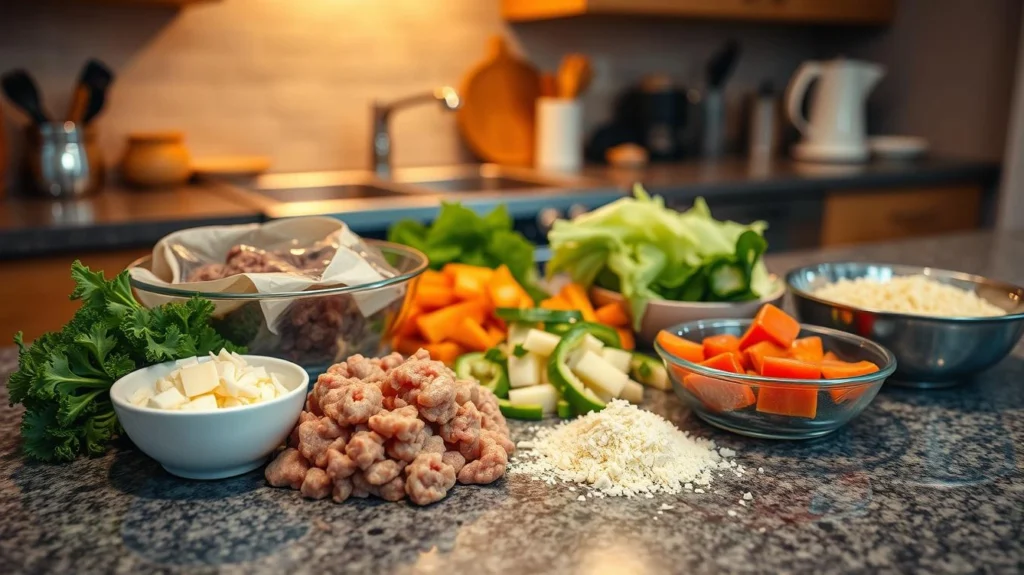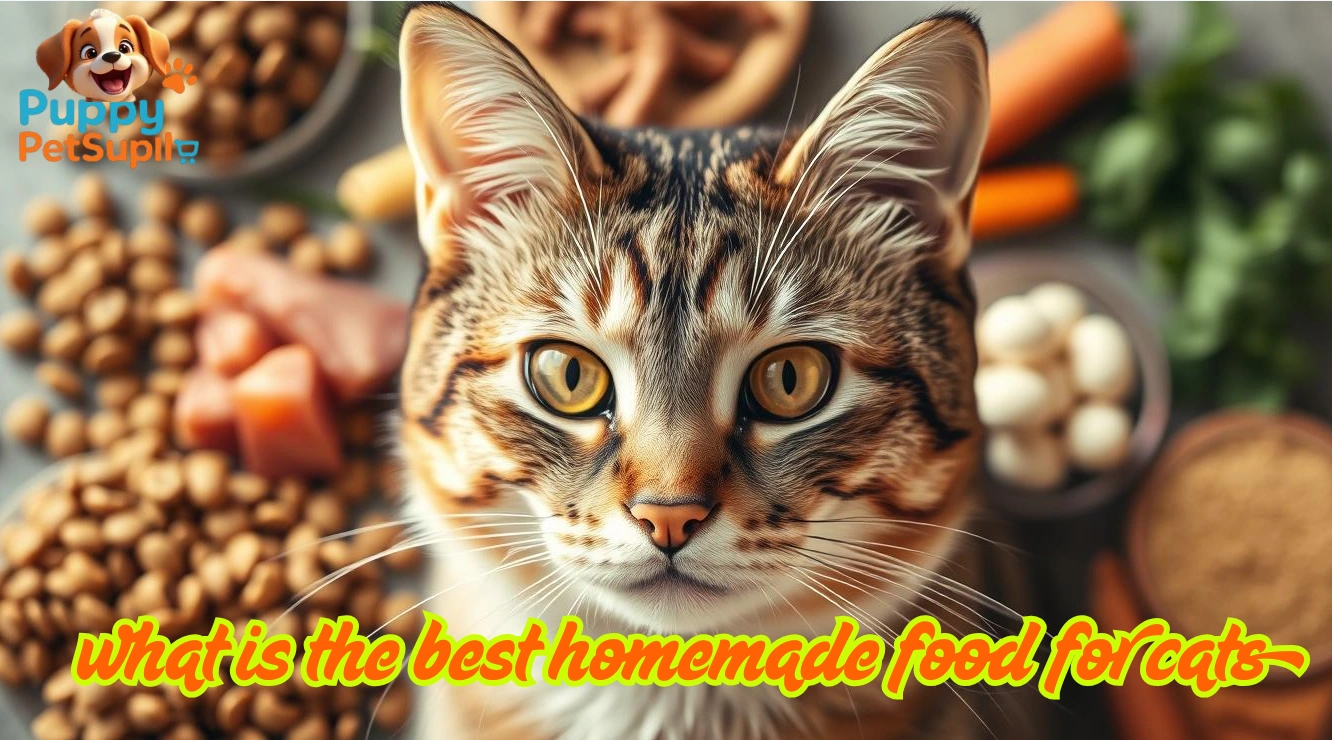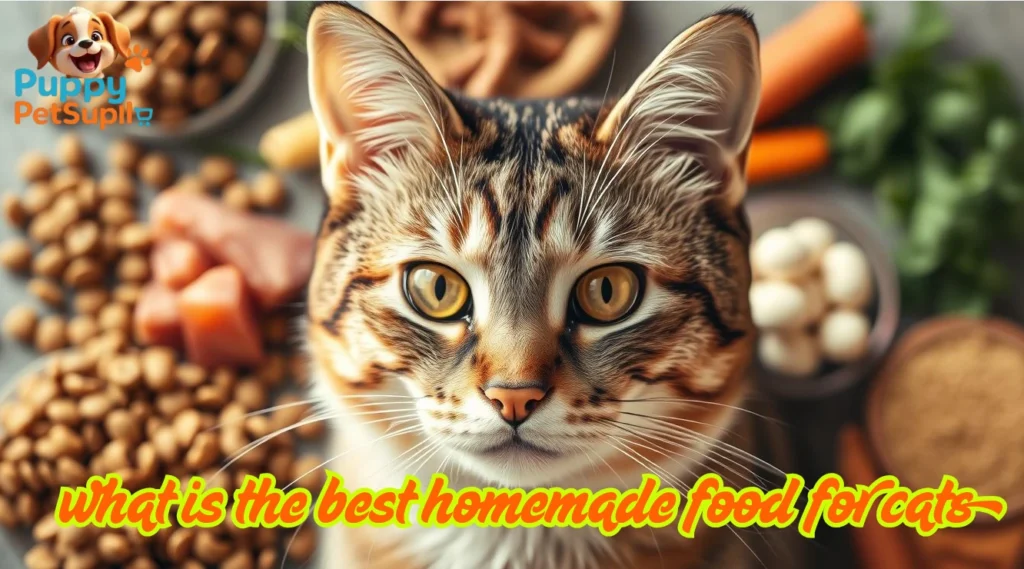Homemade Cat Food: What to Feed Your Feline?
We all want the best for our cats, and their diet is no exception. With worries about commercial cat food growing, many are choosing natural cat food. Did you know lots of cat owners now make homemade cat food for a healthy diet?
What is the best homemade food for cats?
When you cook for your cat, you pick the ingredients. This means your cat gets the nutrients they need without harmful additives. Knowing about cat nutrition helps you make a balanced meal. This can greatly improve your cat’s health.
Key Takeaways
- Concerns over commercial cat food are driving the shift towards homemade options.
- A healthy diet is key for your cat’s well-being.
- Understanding cat nutrition is vital for balanced homemade cat food.
- Homemade cat food lets you control what goes into your cat’s meals.
- Natural cat food is a better choice than some commercial diets.
Understanding Your Cat’s Nutritional Needs
Cats need a diet full of protein and special nutrients found in meat. Their diet must meet these needs to keep them healthy.
Essential Nutrients for Feline Health
Cats need protein, vitamins, and minerals to stay healthy. These nutrients help with energy and keeping the immune system strong.
The Importance of Protein in Cat Diets
Protein is key for a cat’s diet. It helps build muscles, skin, and other tissues. Cats do best with a diet rich in animal-based protein.

cat nutrition
Balancing Fats, Vitamins, and Minerals
Cats also need a mix of fats, vitamins, and minerals. Fats give energy, while vitamins and minerals help with bone health and the immune system.
Knowing and meeting these nutritional needs helps our cats live happy, healthy lives.
Benefits of Homemade Cat Food
Making homemade cat food lets us control what our cats eat. This way, we can make sure they get the nutrients they need. We avoid the additives in commercial cat food.
Quality Control and Ingredient Transparency
One big plus of homemade cat food is controlling the ingredients. We pick fresh, whole foods and skip the fillers and preservatives. This means we know exactly what our cats are eating.
Addressing Specific Health Concerns
Homemade cat food helps us meet our cat’s special dietary needs. If our cat has allergies or medical conditions, we can make their meals just right. This can really help their health.

benefits of homemade cat food
Cost Considerations Over Time
At first, making homemade cat food might cost more. But it can save money in the long run. By feeding them right, we might avoid expensive vet bills.
| Benefits | Description | Advantages |
| Quality Control | Control over ingredients | Fresh, whole foods |
| Addressing Health Concerns | Tailored diets for specific needs | Improved health outcomes |
| Cost Considerations | Potential long-term savings | Reduced veterinary bills |
What Is the Best Homemade Food for Cats?
To make the best homemade food for cats, focus on their dietary needs. Cats need a diet rich in protein from animal sources. A good homemade cat food should mix protein, organ meats, and supplements like vegetables and grains.
Protein-Based Options
Protein is key for a cat’s diet. Chicken, turkey, and fish are great protein sources. They give cats the amino acids they need for health.
| Protein Source | Nutritional Benefits |
| Chicken | Rich in protein, vitamins B6 and niacin |
| Turkey | High in protein, phosphorus, and selenium |
| Fish | Excellent source of omega-3 fatty acids and protein |
Organ Meats and Their Nutritional Value
Organ meats like liver and kidney are packed with nutrients. They are full of iron, vitamin A, and other important nutrients for cats.
“Organ meats are a key part of a cat’s diet, providing essential nutrients for health.”
Supplementing with Vegetables and Grains
Cats don’t need a lot of vegetables or grains. But, pumpkin, carrots, and sweet potatoes can be good in small amounts. They help with digestion.
By using these ingredients in a balanced recipe, cat owners can give their pets a healthy diet.
Essential Ingredients for Homemade Cat Food
Choosing the right ingredients is key when making homemade cat food. The quality and type of ingredients greatly affect your cat’s diet balance.
High-Quality Protein Sources
Protein sources are vital for a healthy cat diet. Chicken, beef, and fish are great because they have essential amino acids cats need.
| Protein Source | Nutritional Benefits |
| Chicken | Rich in protein, low in fat |
| Beef | High in iron and protein |
| Fish | Rich in omega-3 fatty acids and protein |
Necessary Supplements and Additives
Some supplements are needed to ensure a balanced diet. Taurine, vitamin E, and omega-3 fatty acids are often added to homemade cat food.
Ingredients to Avoid in Cat Food
It’s also important to know what to avoid. Onions, garlic, and chocolate are toxic to cats and should not be used in homemade cat food.
Preparing Raw Homemade Cat Food
Making raw homemade cat food is more than picking the right ingredients. It also means handling and preparing it safely and nutritionally. We’ll show you how to do it right.
Safety Precautions When Handling Raw Ingredients
When working with raw ingredients for your cat’s food, safety is key. Always wash your hands thoroughly before and after handling raw meat. Make sure all utensils and surfaces are clean and disinfected. Proper storage of raw ingredients is also vital to prevent contamination.
Step-by-Step Raw Cat Food Recipe
Here’s a simple recipe to start with: Mix 1 pound of raw, ground meat (like chicken, turkey, or beef), 1 egg, 1 teaspoon of fish oil, and a pinch of salt in a bowl. Mix well and serve. You can add finely chopped veggies like carrots or green beans for extra nutrition.
Storage and Serving Guidelines
After preparing the raw cat food, proper storage is critical. Divide the mixture into individual servings and put them in airtight containers in the freezer. Thaw frozen portions in the fridge or at room temperature before serving. Always check the food for spoilage before giving it to your cat.
By following these steps and the recipe, you can give your cat a nutritious and safe raw homemade cat food diet.
Cooking Homemade Cat Food
For cat owners who want to control their pet’s diet, cooking homemade cat food is a good choice. It lets you pick the ingredients and make sure your cat gets the nutrients they need.
Simple Cooked Cat Food Recipes
Cooked cat food recipes are easy to make. You can try boiled chicken and rice or cooked salmon with sweet potatoes. These recipes offer a good balance of protein, fat, and carbs.
- Boiled chicken and rice
- Cooked salmon with sweet potatoes
- Steamed green beans and turkey
Maintaining Nutritional Value While Cooking
To keep your cat’s food nutritious, cook the ingredients gently. Steaming or boiling is best because they save nutrients. Don’t overcook, as it can destroy vitamins and minerals.
Tips for maintaining nutritional value:
- Cook ingredients gently
- Avoid overcooking
- Use a variety of ingredients
Batch Preparation and Freezing Tips
Cooking in bulk and freezing is a smart way to prepare meals. Cook a big batch, divide it into portions, and freeze. Then, just thaw and serve when you’re ready.
Batch preparation tips:
- Cook a large batch of food
- Portion it out into individual servings
- Freeze for later use
Transitioning Your Cat to Homemade Food
Switching your cat to homemade food needs patience and a good plan. Cats like routine, so changing their diet can be tough. It’s important to introduce new foods slowly to prevent stomach problems.
Gradual Introduction Methods
Start by adding a little homemade food to their usual meal. Slowly increase the homemade food over 7-10 days. This helps their stomach get used to the change.
Monitoring Your Cat’s Response
Watch how your cat reacts to the new food closely. Look at their appetite, energy, and how their stool looks. If they seem sick or have bad digestion, talk to your vet right away.
Addressing Common Transition Issues
Some cats might not like the new food or have stomach problems. Try warming the food to make it smell better or add a bit of low-sodium chicken broth. If these tips don’t work, get help from a vet to check for health issues.
- Gradually introduce new foods to prevent digestive upset.
- Monitor your cat’s overall health and adjust the diet as needed.
- Consult with a veterinarian if you encounter any issues during the transition.
Conclusion: Creating a Balanced Homemade Diet for Your Cat
Choosing homemade cat food shows you care about your cat’s health. It ensures they get all the nutrients they need. We’ve looked at the key nutrients, the benefits, and how to make it safely.
Homemade cat food lets you pick the best ingredients for your cat. It’s important to mix proteins, fats, vitamins, and minerals right. This helps with health issues and keeps your cat well-nourished.
Keep an eye on how your cat reacts to the food and make changes if needed. With the right planning, homemade food can be a great choice for your cat.
FAQ
Feeding your cat homemade food lets you choose what they eat. It helps with health issues and can save money. This makes your cat healthier and happier.
Cats need a lot of protein, fats, vitamins, and minerals. We must mix these well to keep our cats healthy.
To balance these, use good protein sources and organ meats. Add veggies and grains, but avoid bad ingredients.
Great protein sources are chicken, turkey, fish, and organ meats. They give cats the amino acids they need.
When making raw cat food, handle ingredients safely. Follow storage and serving tips to avoid risks.
Yes, you can cook cat food using simple recipes. This keeps nutrients good. Then, freeze meals for easy use.
To switch to homemade food, start slowly. Watch how your cat reacts and solve any problems that come up.
Avoid using low-quality ingredients and not balancing nutrients. Also, handle raw ingredients safely to prevent health issues.
To balance nutrients, use various high-quality proteins and supplements. Avoid harmful ingredients.
Yes, homemade food can help with food allergies or sensitivities. It lets you tailor the diet to your cat’s needs.

